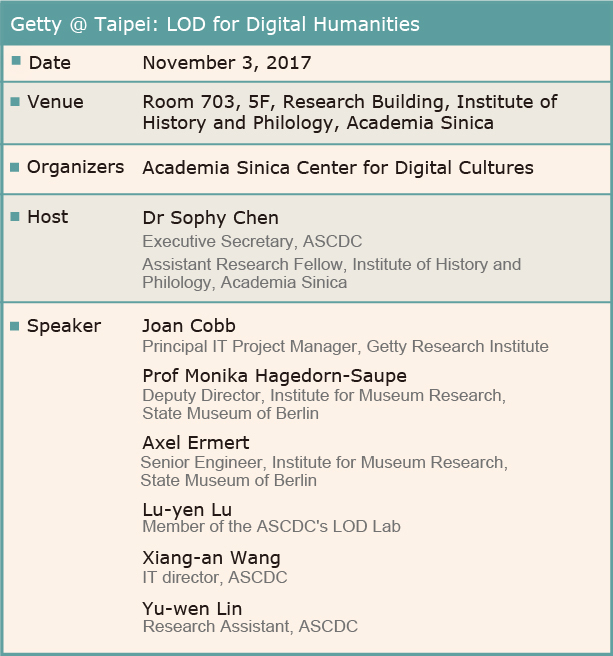(From the left) Dr Sophy Chen, executive secretary of the Academia Sinica Center for Digital Cultures; Joan Cobb, principal IT project manager at the Getty Research Institute; Prof Monika Hagedorn-Saupe, deputy director at the Institute for Museum Research, State Museum of Berlin and Axel Ermert, senior engineer of the Institute for Museum Research meet with members of the Center’s LOD Lab.Joan Cobb giving an overview and prospect of LOD at Getty.Prof Monika Hagedorn-Saupe and Axel Ermert on the German AAT and its entry into Europeana.Conversation further on.Lu-yen Lu, member of the Center's LOD Lab, on the Center's LOD project.IT director of the Center Xiang-an Wang on the technical aspects of LOD.Research assistant Yu-wen Lin on the digital archives and AAT-Taiwan.

By 2018 Getty Research Institute (GRI) is going to complete the LOD conversion and open the access of five authority datasets, including Cultural Objects Name Authority (CONA) and Iconography Authority (IA), to the public. On November 3, 2017 the Academia Sinica Center for Digital Cultures played host to "Getty @ Taipei: LOD for Digital Humanities" and invited Ms Joan Cobb, Principal IT Project Manager at GRI; Prof Monika Hagedorn-Saupe, Deputy Director at the Institute for Museum Research, State Museums of Berlin, and Mr Axel Ermert, Senior Engineer of the Institute for Museum Research to share their experience in the research of digital humanities.
Joan Cobb points out that the abovementioned projects continue Getty's approach to texts and metadata by focusing on the construction of authority files by assigning formal constraints to various information (incl. people, event, place, object etc.) as the basis for controlled vocabularies, in order to establish a standard methodology for the management of cultural heritage.
Founded in 1985, the Getty Research Institute is an international center of the Getty Foundation and dedicated to the preservation and research of cultural heritage and material culture of the visual arts. GRI is a leading organization in the US that pioneers the application of digital technology to art-historical research and the humanities. With its sustained effort in building information system for cultural heritage, the Research Institute advocates introducing Linked Open Data (LOD) to cultural management, envisioning a global network to further knowledge.
LOD refers to data that is semantically linked by following a designed set favoring interlinking structured data made available for use, reuse, and redistribution on the visible web. Being free of charge and connected to the global community, it breaks down the physical or abstract boundaries that demarcate nations, institutions or languages.
Since 2014, GRI has been converting the format of Art & Architecture Thesaurus (AAT), Getty Thesaurus of Geographic Names (TGN) and Union List of Artist Names (ULAN) to LOD. The conversion, as Joan Cobb remarks, has covered over 280 million data available to the public (downloadable in JSON, JSONLD, RDF, N-Triples and N3/Turtle).
To enhance access to databases and the reuse-value of data, GRI built Spargl Endpoint that provides authoritative information and structured terminology for art and other material culture. End-users may familiarize themselves with the mechanism of LOD by using this site as well. In addition, Public Discussion Forum is launched in support of this educational cause, providing online discussion to present the ontology structure of LOD and how to use it.
Next on Getty's agenda: LOD conversion on the increase. Among the projects are Getty Publication, Getty Conservation Institute Science Data, Getty Research Institute Provenance Indexes and AATA Online. This seems to be indicative of a nascent trend, where the Academia Sinica Center for Digital Cultures has a part to play.
The Center's pilot scheme, Taiwan e-Learning and Digital Archives Program, has been Getty's partner since 2008 to translate its Art & Architecture Thesaurus into Mandarin. The work amounts to Art & Architecture Thesaurus-Taiwan, the Chinese version of AAT containing 34,000 translated entries and contributions of entries about Chinese calligraphy and traditional Chinese festivals.
Since 2010 the Center has been a regular participant of the plenary sessions of International Terminology Working Group (ITWG). Every year it meets with members of the AAT working group from the US, Netherlands, Germany and Chile to talk about their recent work and findings in advancing LOD.
AAT is a multilingual database characterized by three types of semantic relationships, i.e. equivalence, hierarchical and associative. It encompasses different professional fields such as the arts, architecture, installation, material culture and medium, serving as an important reference for museum cataloger and archival workers. It also facilitates data retrieval and manages controlled vocabularies for digital archives, given that information access is fundamental to research in the Humanities.
In parallel to developing LOD, Getty holds a keen interest in boosting the circulation and creative use of cultural heritage. It has released roughly 30,000 high-resolution images of artworks from the Getty Collection for free download.
"We hope these images and index data to be the sources that inspire information scientists and the public to embark on new projects," says Cobb.
"However," as Dr Sophy Chen, executive secretary of ASCDC, raises an issue in recognition of Getty’s recent release as signaling a future trend, "we are led to think about what can be done to the scruples of collectors, who need some reassurance regarding how the images, once released, can be appropriatelytraced in their afterlife."
Prof Monika Hagedorn-Saupe and Mr Axel Ermert come to present the current state of the German version of AAT. Their presentation offers an overview of how the Institute for Museum Research manages to incorporate digital data provided by different institutions in different languages into Europeana to a unified standard.
"What happens is that the data will first be made compatible with the semantic requirements of LIDO (Light Information Describing Objects). Then it will be uploaded to an aggregator before entering the depository of Europeana."
The topic presented by the LOD Lab of ASCDC pertains to how the Lab’s LOD conversion project deploys OpenRefine to better define and aggregate data. Cobb has expressed support for further exchange, if there is any difficulty in furthering the project.